

GRACELAND'S HOUSE SYSTEM |
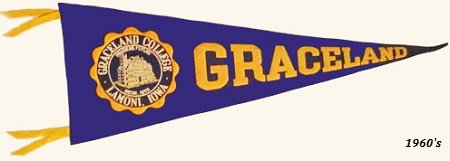 |
|
In 1962, it was believed that Graceland's social clubs had become
too divisive and that more mature student activities were needed as the
college evolved from a junior college into a four-year institution.
Following months of study conducted by the Council on Student Life
(CSL), student polls and all-campus meetings, social clubs would come to
and end upon the conclusion of the 1961-62 school year. During a special
session held on Monday, May 7, 1962, the faculty approved the CSL's
proposed reorganization, primarily designed by Dave Haseltine,
Graceland's director of housing, based upon a model used by Iowa's
Grinnell College. A “house” grouping would be organized with 45 to 67
students and a faculty associate who would serve as a pastor and
sponsor. Each house would elect their own council members to include a
president, a vice-president/treasurer, a vice-president/secretary, a
social chair, two senators, a chaplain and an intramural or Women's
Recreational Association manager. Each men's house would be paired with
a women's house to form a pastoral group (brother/sister house). An
inter-house court consisting of five men and five women who were
nominated by houses was established to deal with housing problems. Some
of these elements were already in place under the basic residence unit
system that was introduced on-campus in 1956. Student dormitories were organized into seven men's houses and seven women's houses and another house for married students. On Tuesday, May 8, 1962, the CSL elected the following students as first house presidents for the upcoming school year, 1962-63: Jim Gargano, Leighton Leighty, Jim Elvin, Jim Zimmer, Lance Hutton, Dan Shank, James Warnock, Rita Norvell, Judy Manning, Carolyn Carter, Sharon Pray, Shirley Bigham, Margo Montgomery, Sue Fisher and Julie Fletcher. One of the women was to be appointed as a vice-president for the president of the house composed of Derry, East and Weldon's Halls. House names were not chosen until the following hall. In October of 1962, the Council of House Presidents accepted the first 13 of 15 house names, which were: Men's Houses: Edwards House at Baker Hall, Tiona House at Ullery Hall, Aaron House at Herald Hall, Closson House at Gunsolley's first floor, Agape House at Gunsolley's 2nd floor, Stewart Manor at Gunsolley's 3rd floor, and Faunce House at Gunsolley's 4th floor. Women's Houses: Traver House at Walker Hall 1st and lower levels, Shalom at Walker Hall 2nd level, Kimball Manor at Walker Hall 3rd level, Sariah House at East, Derry and Weldon's Halls, Belavera House at Tess Morgan Hall south wing (the only wing existing at the time), and Audentia House at Patroness Hall east and west wings. Later in October, the following were approved: Electa House for married students and Solah House in Patroness Hall north. To avoid repetition, all houses were required to submit their insignias, colors, mottos and crests to Lance Hutton, CHP vice-president. Each House has officers who serve on Graceland’s Student Government. The officers form a “House Council,” including a House President (who leads the House Council), a Campus Organization of Social Activities (COSA) representative, an Academic Student Council (ASC) representative, a senator, an intramural sports representative and a chaplain. Members of the House Council are elected to their positions by members of their House. In addition to their Student Government duties, House Council members plan social activities called “functions.” These functions vary by House and range from formal dinners to campouts. Each school year the houses moved from dormitory to dormitory or floor to floor. The Administration permanently established the men's house locations during the 1976-77 school year and in the 1979-80 school year for the women's houses. Over the years, new houses were created and existing houses merged or ended due to developments such as the construction of Graybill Hall and the conversion of Patroness Hall into offices. Following is a complete list of Graceland's known houses up to 2013: |
| Aaron ~ formed 1962 | Agape ~ formed 1962 | Amici ~ formed 1985 | |
| Ananta ~ 1965-1979 | Aponivi ~ formed 1979 | Atara ~ 1979-1985 | |
| Audentia ~ 1962-1979 | Belavera ~ 1962-1985 | Chemin ~ 1967-1979 | |
| Cheville ~ formed 1965 | Closson ~ formed 1962 | Dimora ~ 1965-1979 | |
| Edwards ~ 1961-1985 | Electa ~ 1962-1985 | Faunce ~ formed 1961 | |
| Hanthorne ~ formed 1994 | Higdon Manor ~ 1967-1968 | Khiyah ~ formed 1994 | |
| Kimball Manor ~ 1962-1979 | Kimora ~ 1979-1985 | Leilani ~ formed 1985 | |
| Mahana ~ 1967-1979 | McKevit Manor ~ formed 1970 | Orion ~ formed 1985 | |
| Paloma ~ formed 1966 | Powell ~ formed 2013 | Sariah ~ formed 1962 | |
| Shaddai ~ 1985-1991 | Shalom ~ formed 1962 | Solah ~ formed 1962 | |
| Stewart Manor ~ formed 1962 | Tiona ~ 1962-1985 | Traver ~ 1962-1985 |
| Aaron House |
 Among
the first of Graceland's first houses to be named in October of 1962 was
Aaron house, a men's residence house. The name comes from the Book of
Mormon's Aaronic priesthood, the name Aaron derived for Moses' brother
Aaron. Suggested by Neil Francis, the name was selected by the house
members during the naming contest. During its initial year with James
Warnock serving as house president, Aaron House was located in Herald
Hall. Among
the first of Graceland's first houses to be named in October of 1962 was
Aaron house, a men's residence house. The name comes from the Book of
Mormon's Aaronic priesthood, the name Aaron derived for Moses' brother
Aaron. Suggested by Neil Francis, the name was selected by the house
members during the naming contest. During its initial year with James
Warnock serving as house president, Aaron House was located in Herald
Hall.Since its inception, Aaron House's mascot has been a symbol of courage and strength – a knight. Consequently the first house members became Knights during a “Knight's Out” function, an annual event during which new house members were formally inducted during a knighting ceremony. The initial house colors were black (a symbol of chivalry), white (a symbol of purity) and red (symbolizing courage and bravery). In the fall of 1976, Aaron House moved to the fourth floor of Gunsolley Annex (present-day Graybill Hall). The house relocated to the first two floors of Gunsolley Hall in the fall of 1977. Brian Carr designed the knight, armor and shield for what would become the house's logo which was introduced in 1977-78 on what would become a familiar red Aaron House jacket. The following year, Aaron's sister house, Solah, copied the jacket's design. A sidewalk rope climb during homecoming has become the house's notable traditions, begun in 1979. Aaron was also the first house to establish and endowment scholarship fund (under house president Charles Wilmont in 1987-88). Aaron House remains active to the present-day (2015). |
| Agape House |
| Agape House, a men's residence house, was among the first group of houses that selected a name in October 1962. It was the first existing house selected to move into Gunsolley Annex (present-day Graybill Hall) upon the completion of that dormitory in 1965. Agape was still going strong in 2013. |
| Amici House |
 In
1985, Kimora and Traver Houses were merged when Walker Hall closed for
renovations and Amici House was formed. Amici House, a women's residence
hall house, began that fall in the south wing of Tess Morgan Hall. The
name means “friends” Latin and Italian (pronounced with the “c” as a
hard “k” and a long “i”). The house's original officers were president
Lisa Smith, SAC Debbie Bayless, chaplain Dena Perlenfien, Crescent Karen
McLean, senator representative Karen Young, intramural Shauna Trachsel
and COSA representative Beth Eichfield. Pink, gray and white were the
house's original colors. Gumby was adopted as the original house mascot,
chosen because this character had the ability to bend and stretch in any
situation that arose. During the 1986-87 year, Amici House adopted the
penguin as its mascot; later still during the 1989-96 period the penguin
was replaced with a cow. In
1985, Kimora and Traver Houses were merged when Walker Hall closed for
renovations and Amici House was formed. Amici House, a women's residence
hall house, began that fall in the south wing of Tess Morgan Hall. The
name means “friends” Latin and Italian (pronounced with the “c” as a
hard “k” and a long “i”). The house's original officers were president
Lisa Smith, SAC Debbie Bayless, chaplain Dena Perlenfien, Crescent Karen
McLean, senator representative Karen Young, intramural Shauna Trachsel
and COSA representative Beth Eichfield. Pink, gray and white were the
house's original colors. Gumby was adopted as the original house mascot,
chosen because this character had the ability to bend and stretch in any
situation that arose. During the 1986-87 year, Amici House adopted the
penguin as its mascot; later still during the 1989-96 period the penguin
was replaced with a cow.Unlike any other women's residence hall, Amici House had two male co-vice presidents during its first year – Todd Davison and John Snider of Cheville House. Both Davison and Snider heard that there was some concern about favoring either Kimora or Traver House when selecting Amici's vice-president and consequently volunteered. Tess Morgan Hall's head resident Betty Winholtz stated that there were no rules which prohibited the selection of two males as vice-presidents of a women's house. Davison and Snider attended the house's functions and were present to appear in the house photograph. Beginning in the fall of 1966 semester, Amicic House was reduced to the two west side floors of Tess Morgan Hall which provided better unity among the house membership. Todd Davison wrote the lyrics of Amici House's song: |
|
It is my joy in life to find at every turning of the road The strong arm of a comrade kind to help me onward with my load. And since I have no gold to give, and love alone can make amends, My only prayer is, while I live – God make me worthy of my friends. Amici, oh Amici, House of Friends. Amici, oh Amici. God make me worthy of my friends. |
| Ananta House |
 In
the spring of 1965 Ananta House, a women's residence hall house, was
established when the north and west wings of Tess Morgan Hall were added
to the dormitory. The decision was made to house separate residence hall
houses in each wing. In
the spring of 1965 Ananta House, a women's residence hall house, was
established when the north and west wings of Tess Morgan Hall were added
to the dormitory. The decision was made to house separate residence hall
houses in each wing.”Ananta” is a Hindu term signifying “infinite love”. The house's symbol is three interlocking circles which represent faith, hope and love. Coral and white were chosen as the house's original colors. Volunteers from other houses became Ananta House's original officers: president Mary Jane Donnelson, vice-president Phyllis “Dee” Carlson (who also filled the office of secretary), senate representatives Mary Jo Huffer and Ruth Darlene Siler, co-chaplains Janie Warnock and Marcy Iseman and Crescent Barbara Strom. Ananta House song was: Ananta, the symbol of
infinite love, |
| Aponivi House |
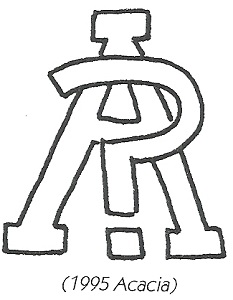 When
Chemin and Mahana Houses combined in 1979, Aponivi House was founded. A
women's residential hall house, the two former houses merged upon the
decision to turn Patroness Hall into offices in the spring of 1979.
Chemin had been located on the second floor of Walker Hall and Mahana
was on Walker's third floor. Because both houses enjoyed a good
relationship and were close to one another, they volunteered to combine.
The decision was formally announced during a drawing on Wednesday, April
4, 1979 at the Memorial Student Center. Aponivi House made its debut the
following fall, occupying the top two floors of Walker Hall. When
Chemin and Mahana Houses combined in 1979, Aponivi House was founded. A
women's residential hall house, the two former houses merged upon the
decision to turn Patroness Hall into offices in the spring of 1979.
Chemin had been located on the second floor of Walker Hall and Mahana
was on Walker's third floor. Because both houses enjoyed a good
relationship and were close to one another, they volunteered to combine.
The decision was formally announced during a drawing on Wednesday, April
4, 1979 at the Memorial Student Center. Aponivi House made its debut the
following fall, occupying the top two floors of Walker Hall.“Aponivi” is a Hopi word which means “where the wind blows.” House members selected the word on Thursday, September 13, 1979 due to the church's Lamanite heritage and after one member asked, “Have you ever been here [Graceland Campus] in the wintertime?” Of note, the second choice under consideration was “Chehana”, a combination of the names of the merging houses. Aponivi was approved for a house name by the Executive Advisory Council on Tuesday, September 18, 1979. Original house colors were cranberry and white, which were changed a few years later to navy blue and white. Aponivi's original house council members were: president (first semester only) Carina Lord, Council on Academic Development representative Dana Kelly, COSA representative Kristi Parker, chaplain Lisa Terada, intramural representative Lori Burnell, Crescent April Sherman, senator Cindy Weldon and treasurer Donna Blair. The house symbol was an “A” and a question mark – meaning things yet to be revealed in the future and questions people ask as they discover their hidden potential. Aponivi's brother house was Aaron House. Aponivi House moved to the middle floor of Tess Morgan Hall's north wing when Walker Hall was closed for renovations. Aponivi returned to the second floor of Walker Hall for the fall 1994 semester. |
| Atara House |
|
Upon the announcement of the college converting Patroness Hall into
offices in 1979, the women's residence hall houses of Ananta and
Audentia merged to create a new house. Audentia, which did not volunteer
to merge, was selected during a drawing out of a hat held in the
Memorial Student Center on April 4, 1979 to join with Ananta House. The
name Atara means “crown” or “royal diadem.” The house symbol was a crown
and the colors of maroon and white were selected. Atara House occupied
the south wing of Tess Morgan Hall. The following served as Atara House's council members: president Margie Lake, social co-chairs Theresa Kaat and Sandi Fugate, intramural representative Karen Smith, SAC representative Julie Snethen, senator representative Susan Pratt, treasurer Lynette Shoemaker, chaplain Gina Parsons and Crescents Liza deGuzman and Shelley Woodson. When Walker Hall closed for renovations after the spring of 1985, some of the women's houses were forced to combine and move to Tess Morgan Hall. The members of Atara House decided that spring to merge with Belavera and form Leilani House located on the lower floor of the west wing at Tess Morgan Residence Hall. |
| Audentia House |
 One
of Graceland's original women's residence hall houses was Audentia House
which was also among the first house names selected in October of 1962.
The house was named in honor of Mary “Audentia” (Smith) Anderson (b.
March 23, 1872; d. February 14, 1921) who was the daughter of RLDS
President Joseph III and Bertha Smith. Audentia was also the first
treasurer of the original Graceland College Alumni Association and wrote
The Old, Old Path. One
of Graceland's original women's residence hall houses was Audentia House
which was also among the first house names selected in October of 1962.
The house was named in honor of Mary “Audentia” (Smith) Anderson (b.
March 23, 1872; d. February 14, 1921) who was the daughter of RLDS
President Joseph III and Bertha Smith. Audentia was also the first
treasurer of the original Graceland College Alumni Association and wrote
The Old, Old Path.Initially Audentia House was located in the east and west wings of Patroness Hall and during its early years the members wore lavalieres containing Greek symbols [alpha – A; upsilon – U; delta – D]. Carolyn Carter was the first president of the house. The house colors were dark green and light blue. The house symbol was a caricature of a little girl called “Audie” which also was the house's nickname. An Aaron-Audentia newspaper entitled The Lance was published first on November 7, 1963 with Leon England as editor and Neil Francis co-editor. Audentia House was relocated to various floors and residence halls each school year until in it was placed in the lower level of the west wing of Tess Morgan Hall during the 1978-79 school year. In March of 1979 it was announced that Patroness Hall would be converted from a women's dormitory into offices. Consequently, five women's houses volunteered to combine. On April 4, 1979 a drawing was held in the Memorial Student Center to determine house mergers. G.S.G. President Ken McClain pulled Audentia's name from a hat and it was merged with Ananta House. The two houses combined their name and formed Atara House. Lyrics to Audentia House song, Audentia, My Home are as follows, set to the tune of Sent Forth By God's Blessing: |
|
Upon yonder green hill on Graceland's fair campus Amid the dark pine trees where I love to roam With my friends most dear or in solitude quiet, My heart reaches out to Audentia my home. Tis there where strong bonds of life-long and true friendship Are formed with my sisters, the Audentia girls. The fellowship, fun and the quiet devotion; All these go to make Audentia my home. |
| Belavera House |
 One
of the original women's residential houses founded when the house system
was enacted at Graceland College in the fall of 1962 was Belavera House.
The house name was among the first group selected in October of 1962. One
of the original women's residential houses founded when the house system
was enacted at Graceland College in the fall of 1962 was Belavera House.
The house name was among the first group selected in October of 1962.”Belavera” means “truth and beauty” in the international language of Esperanto, and thus, was chosen to symbolize Graceland's status as an international institution. Belavera's house creed was also “truth and beauty.” The house colors were maroon and cream. Tigger from Winnie the Pooh was the house mascot in 1980, and Belavera's symbol was a cross with a rose – a symbol of truth and beauty. Although Tess Morgan Residential Hall had been completed as far as the south wing in 1962, Belavera House was located in this hall originally with Rita Norvell serving as the first house president. Belavera was housed in several locations over the years [one being Patroness Hall from 1970-1974 when I was a member and a student at Graceland ~ S.R.B.] until it was permanently located on the bottom floor of Tess Morgan's west wing in 1979. After the spring of 1985, Walker Residential Hall was closed for renovations. At this time Belavera and Atara Houses agreed to merge, forming Leilani House. Leilani House was then located in the lower level of Tess Morgan's west wing in the fall of 1985. Kathy Kent and Della Shaw wrote Belavera Love, Belavera House's song: |
|
We came here as strangers searching for new friends We leave here as sisters, a bond that never ends. (CHORUS:) Belavera Love is truth and beauty to me. The friendships that we make here will last eternally. The memories that we share will never fade away. Our Belavera Love, with us, will always stay. In times of joy or sadness someone will be there, reaching out to you saying that she cares. (CHORUS:) Our Belavera Love means unity to me Sharing hopes and dreams of the future that we see. (CHORUS:) This year spent together will linger in our hearts. The friendships will remain, even when we part. (CHORUS:) |
| Chemin House |
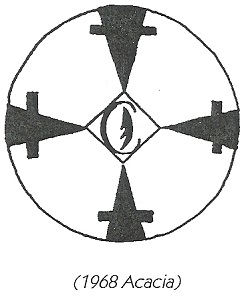 In
the fall of 1967, Chemin House, a women's residence hall house, was
began in the east and west wings of Patroness Hall. Chemin House was
created because Mahana House, also newly created, was scheduled to
occupy Patroness and Graceland felt this would make Mahana too large of
a house. “Chemin” is a French term which means “way”, “road” or “path”
and is pronounced “she-min.” House colors were lavender and burgundy.
Both Chemin and Mahana shared Agape as their brother house during the
first semester of their existence. In
the fall of 1967, Chemin House, a women's residence hall house, was
began in the east and west wings of Patroness Hall. Chemin House was
created because Mahana House, also newly created, was scheduled to
occupy Patroness and Graceland felt this would make Mahana too large of
a house. “Chemin” is a French term which means “way”, “road” or “path”
and is pronounced “she-min.” House colors were lavender and burgundy.
Both Chemin and Mahana shared Agape as their brother house during the
first semester of their existence.Chemin original house officers included: president Sharon Engle, vice-president and senator representative Cathy Harrop; secretary-treasurer Della Dennis; chaplain Charlene Shank; assistant chaplain Sharon James; social chair Karen Ritchie; W.R.A. Representative Jane Miller; Crescent Joy Armstrong; and, historian Ruth Walrath. Chemin House occupied several floors in various buildings every school year until it gained permanent residency on the second floor of Walker Residence Hall in the fall of 1977. In the spring of 1979, Graceland decided to convert Patroness Residence Hall into offices. Chemin was one of five women's houses that volunteered to combine in exchange for first choice of residency location the following fall. Due to Chemin's good relationship with Mahana on Walker's third floor and the house wished to remain in Walker Hall, the two houses merged, thus bringing their existence full circle. On April 4, 1979 the merger became official and was named Aponivi House that fall. Joy Armstrong wrote the lyrics for Chemin's House song: |
|
Chemin, our home upon the Graceland hill, We treasure days that we have spent here. Our hearts will ne'er forget the bonds of love We have shared throughout the years. And when the moment comes for paths to part, Oh Lord, our solemn prayer will be That we may ne'er forget the bonds of love We have shared throughout the years. |
| Cheville House |
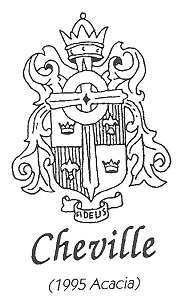 During
the spring of 1965, and in anticipation of Gunsolley Annex (present-day
Graybill Hall) opening in the fall of 1966, a new men's residence hall
house was created. Roy E. Brown suggested the name Cheville House to
honor religion Professor Roy Cheville who taught from 1923-1960). During
the spring of 1965, and in anticipation of Gunsolley Annex (present-day
Graybill Hall) opening in the fall of 1966, a new men's residence hall
house was created. Roy E. Brown suggested the name Cheville House to
honor religion Professor Roy Cheville who taught from 1923-1960).During its first two years, Cheville House was located on the first floor of the Annex. Original house colors were forest green and black, but later changed to green and yellow. The original house symbol was a cross (Christianity) with a circle that passed being the cross' horizontal arms and in front of the vertical lines (symbolizing unity) and the letter “C” in the center. The house symbol was later changed to a coat of arms. Cheville House's original council members were: president Roger W. Hershey; vice-president/secretary Robert Ritchie; vice-president/treasurer Gordon Suddaby; senator representatives Clare D. Vlahos and Steve l. Raiser; chaplain Garland M. Land; assistant chaplain Earnie Garner; intramurals chair Chuck Harris; assistant intramurals chair Harold G. Hawley; and social chairman Stephen “Bruce” Hobart. Cheville House was located in various locations until the fall of 1976 it was moved to the second floor of Gunsolley Annex (present-day Graybill Hall) when Graceland's administrators decided to keep each of the men's houses at their existing location permanently. Around the year 1988 Cheville's house mascot name became “The Cheville Gods.” |
| Closson House |
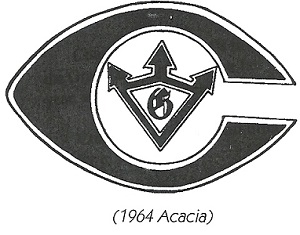 Closson
House, one of the original house names selected in October of 1962, was
named in honor of Eugene Closson who was the psychology instructor from
1931 to 1959. Originally the house had 18 members residing on the first
floor of Gunsolley Hall and a few other male students who lived uptown.
Original house colors were scarlet on white. Closson
House, one of the original house names selected in October of 1962, was
named in honor of Eugene Closson who was the psychology instructor from
1931 to 1959. Originally the house had 18 members residing on the first
floor of Gunsolley Hall and a few other male students who lived uptown.
Original house colors were scarlet on white.Closson House's first president was Leighton Leighty. During the 1962 homecoming, Closson House won first prize in the house float competition which awarded at $25 theater party and a large group portrait of the house. Closson House moved to several locations over the years until in the fall of 1976 it was permanently housed on the third floor of Gunsolley Hall. |
| Dimora House |
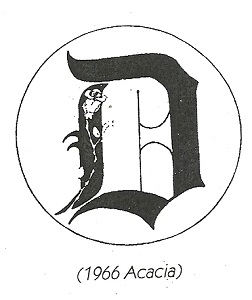 In anticipation of the completion of Tess Morgan Residence Hall's north and west wings, Dimora House was created in 1965. Dimora was located in Baker Hall for the 1965-66 school year, then relocated in the lower level of Tess Morgan Hall's west wing when it opened in the fall of 1966. Before it was named, Dimora was known as “the new house” and some house members jokingly called it the “Gnu House.” Dimora means “home in Italian. House colors selected were cranberry and mauve. Dimora's first council members were: president Marge McCauley, chaplain Mary Jacks, Crescent Norma Hall, COSA representatives Jane Banks and Karen Nelson, vice-president and secretary-treasurer Claudia Shanklin, and W.R.A. Representative Linda Smith. Lyrics of the house song, Sisters of Dimora, were: |
|
Sisters of Dimora are we - I'll cry when you're sad, I'll laugh when you're happy, For Sisters of Dimora are we, And a bond of love ties us in unity. Together we'll walk - Together we'll talk - I'll give you my hand And try to understand, And from Christ above We will learn to work in love My family, my sisters, my friends. You'll share with me your dreams, And I'll share with you my schemes. You'll share with me your fears, And I'll share with you my tears, And together our love will grow As we fight each other's foes - My family, my sisters, my friends. Upon Graceland's hill Our hearts, they will fill With the power of God's light That overcomes the night. And sisters we'll always be From now 'til eternity. For Sisters of Dimora are we. |
| Over the years Dimora was located on various floors and buildings until the house established permanent residence on the main floor of Walker Residence Hall in the fall of 1978. In the spring of 1979, it was decided to convert Patroness Residential Hall into offices. Dimora was one of five women's houses that volunteered to combine and get first choice of residency location in the fall. On Wednesday, April 4, 1979 at the Memorial Student Center, G.S.C. President Ken McClain drew names out of a hat and matched Dimora with Kimball Manor House. The two houses consequently merged to for Kimora the next fall. |
| Edwards House |
 Edwards
House, named after F. Henry Edwards of the RLDS First Presidency and
Blanche Edwards who served on Graceland's Board of Trustees, was
originally a basic residence unit located on the first floor of Herald
Hall in September of 1956. Edwards
House, named after F. Henry Edwards of the RLDS First Presidency and
Blanche Edwards who served on Graceland's Board of Trustees, was
originally a basic residence unit located on the first floor of Herald
Hall in September of 1956.Under the new housing system put into place during October of 1962, Baker Hall became home for the men of Edwards House. Edwards was one of three names that carried over into the new housing system. James Elvin was the first house president. During the early years, Edwards' house colors were orange and black and used a stylized “E” for its symbol. The house call was “Ar er ahh,” said that a good Edwards House call could be heard all the way downtown. Over time, the house colors became yellow and black; a lion was adopted as the house mascot. Edwards House's long-time tradition was “Big E Night” during which house members would apply “E”s of various sizes across campus the night before the homecoming football game. Bill Wenhotz initiated this tradition at the 1968 homecoming – a response to several instances that occurred the previous spring when students broke into the Ad Building to hang their house flags from the tower. Edwards was among the first four houses to occupy Gunsolley Annex (present-day Graybill Hall) when it opened in the fall of 1965, moving into the second floor. Edwards occupied several different locations until the fall of 1976 when Graceland decided to keep residential houses in a permanent site. Edwards' permanent location was the first floor of Gunsolley Hall. Due to declining enrollment, it was announced in February of 1985 that the first floor of Gunsolley Hall would close. Given the choice to either merge with another house or had the house name drawn out of a hat for elimination, Edwards House opted that spring to merge with Tiona House, located on the top floor of Gunsolley. The two houses merged to form Orion House. Lyrics of Edwards House' song, sung to the tune of Hey, Look Me Over, were: |
|
Hey, look us over, lend us an ear, We're all from Edwards and we have no fear. We've got the moves, Babes, we've got the power. You've probably seen our “E” a-hanging up on the tower. Come on now. Hey, look us over, lend us an ear. We're all from Edwards and we have no fear. So if ever you Babes are down and out from dating little boys Call and Edwards Man today. |
| Electa House |
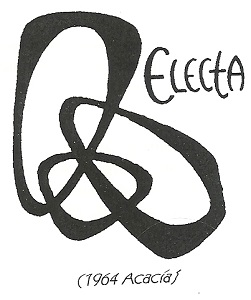 The
first residence hall for married students, Electa House, was organized
in the fall of 1962. Electa was among the last of the original houses to
select a name in October of that year. Electa, as well as Solah for
north Patroness Hall, hadn't been chosen yet when the Council of House
Presidents accepted the first 13 of the original 15 house names earlier
that month. Electa's first house president was Earl Detrick. The
first residence hall for married students, Electa House, was organized
in the fall of 1962. Electa was among the last of the original houses to
select a name in October of that year. Electa, as well as Solah for
north Patroness Hall, hadn't been chosen yet when the Council of House
Presidents accepted the first 13 of the original 15 house names earlier
that month. Electa's first house president was Earl Detrick.The Ball and Chain, Electa's house newspaper, was replaced by The Electa in the fall of 1963 with Maxine Hale, editor, and Diana Shirota, co-editor. The Electa's masthead was wedding rings with the Administration Building tower in the background. This four-page publication included a “Kiddie Korner” which featured stories and puzzles for children, an audience that didn't exist among other house newsletter and newspapers. In 1972, Ullery Hall was converted into an on-campus residence for married students and Electa House gained a physical location. Ullery Hall was renamed Tower Apartments and in the fall of 1985 Electa changed its name to Shaddai house. |
| Faunce House |
 Faunce
House, one of the original house names selected in October of 1962,
originally located on the fourth floor of Gunsolley Hall. The house was
named in honor of Roscoe O. Faunce who taught speech and drama at
Graceland from 1934 to 1960. Faunce
House, one of the original house names selected in October of 1962,
originally located on the fourth floor of Gunsolley Hall. The house was
named in honor of Roscoe O. Faunce who taught speech and drama at
Graceland from 1934 to 1960.The house colors were green and white from the beginning. Faunce's symbol originally was a figure holding a torch and scroll, symbolizing mental and physical development, against a green circle , symbolizing eternal friendship, and a ribbon running through the center with the words “Fraternitas Unitas” meaning “United in Brotherhood.” Daniel Shank was the first house president. Faunce House resided in several locations over the years until moving to the first floor of Gunsolley Annex (present-day Graybill Hall) in the fall of 1976. At this time it was decided to make all of the house locations permanent, so Faunce remained there. During the summer of 1981, rooms 102 and 104 in the northwestern corner were converted into a laundry facility for both Gunsolley and the Annex. Both rooms had once housed a snack shop and had water sources available. Faunce House adopted the yin-yang as its symbol, signifying the strength through common ground that its culturally diverse members possessed during that period. One of the house's annual functions since 1963-64 has been “Faunce Nevada,” where house members set up a mock gambling casino. |
| Hanthorne House |
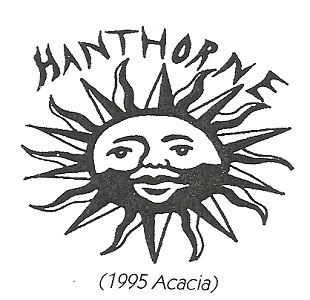 Named in honor of Cleo Hanthorne Moon, Graceland's poet laureate who was the college librarian from 1935 to 1945 and from 1956 to 1969, Hanthorne House was a women's residence hall house that was created during the fall semester of 1994 at the lower north level of Tess Morgan Hall. Hanthorne House was created due to the expansion in the number of women's houses when Walker Hall reopened in 1994. The sun was chosen as the house symbol and the house colors were purple and gold. Hanthrone's first house council members were: president Amy Hough, senator Megan Clinefelter, SAC and peer counselor Monica Nielsen, COSA representative Allison Taylor, chaplain Carrie Rubottom, intramurals representative Musudeen Sinnah-Yovonie, Crescent Tai Field, treasurer Robin Smith, and historian Angie Richardson. |
| Higdon Manor |
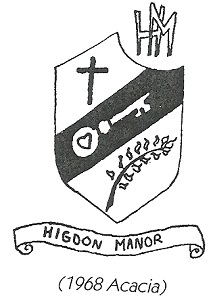 Higdon
Manor was the shortest-lived residence hall house, existing only during
the 1967-68 school year. It was also the first house to disband. Higdon
Manor was the shortest-lived residence hall house, existing only during
the 1967-68 school year. It was also the first house to disband.To accommodate the return of male students to Baker Hall for the 1967-68 school year, Higdon Manor was organized on the first floor of Gunsolley Hall during the spring of 1967. The name was chosen to honor then college president William T. “Bill” Higdon and his father Earl T. Higdon who had also been president of Graceland College. House officers included: president Mike Bessonette, vice-president and senator Larry Beal, chaplain Larry Cole, assistant chaplain Ron Romig, intramurals representative Eldon Anderson, and secretary-treasurer Jack Major. During the year of its existence, Higdon Manor hosted a Western function. The following year, the members of Higdon Manor joined Cheville House. |
| Khiyah House |
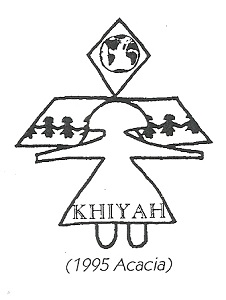 Khiyah
House, a women's residence hall house, began in the fall of 1994 at the
middle level of the north wing of Tess Morgan Hall. Due to the expansion
of residence space for women when newly renovated Walker Hall opened,
the new house was created. On the day that the house members gathered to
select a name, house president Kristi Hettrick told English faculty
member Barbara Hiles Mesle that she wasn't excited about any of the
proposed names. Mesle suggested the name “Khiyah” which means “Mother
Earth” in Hebrew and a name the Mesles had originally planned to use
when naming their daughter Sarah. The word is also similar to a Swahili
term which means “season of new beginnings.” The name was selected. Khiyah
House, a women's residence hall house, began in the fall of 1994 at the
middle level of the north wing of Tess Morgan Hall. Due to the expansion
of residence space for women when newly renovated Walker Hall opened,
the new house was created. On the day that the house members gathered to
select a name, house president Kristi Hettrick told English faculty
member Barbara Hiles Mesle that she wasn't excited about any of the
proposed names. Mesle suggested the name “Khiyah” which means “Mother
Earth” in Hebrew and a name the Mesles had originally planned to use
when naming their daughter Sarah. The word is also similar to a Swahili
term which means “season of new beginnings.” The name was selected.Khiyah's house colors were burgundy and silver; the house symbol involves three interlocking diamonds, a Nordic symbol for heavenly power, which promotes the house's environmental theme. Khiyah's original house council members were: president Kristi Hettrick, senator Brenda Edwards, intramurals representative Sarah Baughman, COSA representative Jennifer Hankins, SAC representative Jana Booth, Crescent Nina Guidry and chaplain Heather Anderson. |
| Sariah House |
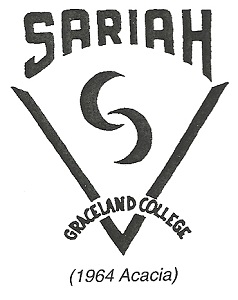 One
of the original women's residence hall houses formed in the fall of
1976, Sariah House was also among the first group of houses to select a
name in October of that year. The house is named for the woman from the
Book of Mormon who was the mother of Nephi and was the wife of Lehi.
During its first year, Sariah House was composed of residents from East
Hall, Derry Hall and Weldon's Hall. The first house president was Judith
Manning. Sariah's brother house was Stewart Manor during the first five
years. Royal blue and powder blue were the house's early color. Members
wore lavalieres containing Sariah's symbol, a triangle with a stylized
"S" in the middle. One
of the original women's residence hall houses formed in the fall of
1976, Sariah House was also among the first group of houses to select a
name in October of that year. The house is named for the woman from the
Book of Mormon who was the mother of Nephi and was the wife of Lehi.
During its first year, Sariah House was composed of residents from East
Hall, Derry Hall and Weldon's Hall. The first house president was Judith
Manning. Sariah's brother house was Stewart Manor during the first five
years. Royal blue and powder blue were the house's early color. Members
wore lavalieres containing Sariah's symbol, a triangle with a stylized
"S" in the middle.After several years at various locations, Sariah made a permanent move to the top floor of the west wing at Tess Morgan Hall in 1978-79. Grace Ebeling wrote the lyrics to Sariah's song, which are sung to the tune of You're Just In Love: |
|
I love Graceland and especially One house there that's made a place for me. In my heart it lives eternally. You wonder who? I'll tell you true. It's the house that gets the best things done. It's the house that has the greatest fun. On my list it always gets the prize - The house I idolize - I'll tell you who. You can stop all your guessin' Because now I'm confessin' That of all houses on the hill My Sariah is strongest And our friendships are longest Bonds of trust hold and always will. From the homecoming playtime To the lilacs in Maytime Lives together build memories Memories that precious grow Pictured in the afterglow Treasures of my heart are these. |
| Shaddai House |
|
In the fall of 1985, the new name of the married students' house,
Electa, became Shaddai House which means "the omnipotent and
all-powerful." The original officers were: president Cindy Pitt,
co-chaplains Brad and Linda Closson, senator Doug Jones, COSA
representatives Robyn and Doug Gunn, intramurals representatives Tim and
Angie Cool, and SAC representative Yoland Porter. The house colors were teal and white, later becoming blue and gold. Around the year 1990, Shaddai adopted the symbol of an eagle flying over a sun. The house dissolved before fall semester of 1991 and its members were included in other residential houses. OASIS (Older Adult Student Information Services) organized that fall to help connect non-traditional students with the student body and to provide campus information. |
| Shalom House |
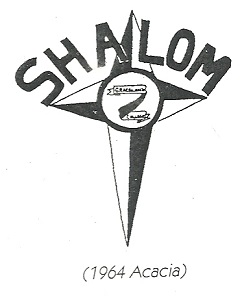 Shalom
House was one of the original women's residence hall houses that began
in the fall of 1962 and was among the first group of houses to select a
name in October. Shalom is a Jewish term conveying the meanings of
"peace by yours", "hello", "goodbye", and "welcome home." Inspired by
the popular musical Fiddler On The Roof and the various meanings of the
word, Patti Roach suggested the name. Initially, Shalom House was
located on the second floor of Walker Hall. The house colors were green
and white; the house symbol was a four-pointed star. Shalom's first
house president was Shirley Bigham from Lancaster, Ohio. Shalom
House was one of the original women's residence hall houses that began
in the fall of 1962 and was among the first group of houses to select a
name in October. Shalom is a Jewish term conveying the meanings of
"peace by yours", "hello", "goodbye", and "welcome home." Inspired by
the popular musical Fiddler On The Roof and the various meanings of the
word, Patti Roach suggested the name. Initially, Shalom House was
located on the second floor of Walker Hall. The house colors were green
and white; the house symbol was a four-pointed star. Shalom's first
house president was Shirley Bigham from Lancaster, Ohio.When the second-phase of the west wing of Tess Morgan Hall opened in the fall of 1966, Shalom and Dimora Houses were the first residence. Shalom and its brother house, Tiona, introduced the "TV Dinner" in the fall of 1980. Shalom continued this tradition with Tiona's successor, Orion House. After several years in various locations, Shalom moved to the middle floor of Tess Morgan Hall's north wing in the fall of 1977. In the fall of 1970, Shalom moved to the main and second floors of Walker Hall. When Walker Hall closed after the spring of 1985, Shalom moved to the top floor of the north wing of Tess Morgan Hall. The lyrics to Shalom House song are: |
|
Shalom, Shalom, you'll find Shalom The nicest greeting you know. It means "bonjour", "salute", and "skoal" And twice as much as "hello." It means a million lovely things Like "peace be yours" - "welcome home." And even when you say "goodbye" If your voice had "I don't want to go" in it Say good bye with a little hello in it And say goodbye with "Shalom." Shalom, Shalom, we've found Shalom. Our home while we're on the hill. It's filled with love and tears and joy And friends that stay with us till We've seen a million lovely smiles And fostered friendships anew And even when we say goodbye Though we know we must go Still we'll always be Sisters forever to stay are we - We're always part of Shalom. |
| Solah House |
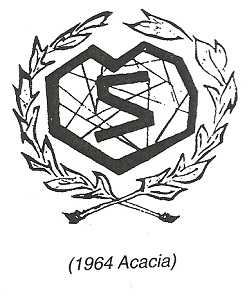 Solah
House was among the first women's residence hall houses that began in
the fall of 1962, and was one of last two of the original 15 houses to
select a name that October. All the other house names had been chosen
earlier in the month when Solah and Electa finally decided on a
designation. "Solah" is an acronym for the house motto "Sisterhood Of
Love And Honor." The house colors are red and white and the original
house symbol was a heart. Solah was originally located in the north wing
of Patroness Hall. Original house officers were: president Margo
Montgomery, vice president/secretary Lila White, social chair Jean
Witte, senator Bonnie Dawson, chaplain Phyllis Sandidge, and Crescent
Sandra Jo George. In the 1963 Acacia Solah and Tiona houses boasted that
they were the first sister-brother houses to have a tug-of-war which
took place across the end of Big G Lake. Solah
House was among the first women's residence hall houses that began in
the fall of 1962, and was one of last two of the original 15 houses to
select a name that October. All the other house names had been chosen
earlier in the month when Solah and Electa finally decided on a
designation. "Solah" is an acronym for the house motto "Sisterhood Of
Love And Honor." The house colors are red and white and the original
house symbol was a heart. Solah was originally located in the north wing
of Patroness Hall. Original house officers were: president Margo
Montgomery, vice president/secretary Lila White, social chair Jean
Witte, senator Bonnie Dawson, chaplain Phyllis Sandidge, and Crescent
Sandra Jo George. In the 1963 Acacia Solah and Tiona houses boasted that
they were the first sister-brother houses to have a tug-of-war which
took place across the end of Big G Lake.Throughout the years Solah House resided in various locations before moving to the lower floor of the north wing of Tess Morgan Hall in the fall of 1976. This was Solah's residence for nearly two decades. In 1994, Solah House's name was drawn as one of the two women's houses that would reside in the newly renovated Walker Hall. Solah moved there onto the top floor in the 1994 fall semester. Lyrics to Solah's House song are: |
|
Together we share the love of Solah sisters, Each year on the hill finding friendship and joy. By faith we search for knowledge and understanding. With Christ as our guide we are bound heart to heart. In our hearts we join to make the Sisterhood Of Love And Honor And this love is in our hearts although we travel far apart. We'll always remember our lives as Solah sisters. And the memories we've shared in our home on the hill. |
| At least during the late 1970's and early 1980's, Solah had an additional, "fun" song that was used for sillier times. It was titled You've Got To Be A Solah Woman, sung to the tune of "You've Got To Be A Football Hero: |
|
You've got to be a Solah woman To get the best of what Graceland can be. You've got to be a hot shot, ooh la la la, If you want to be in Solah with me! Then men of Aaron, Edwards, Closson, Tiona, Agape, Cheville, Faunce, Even the boys of Stewart Manor Would take a Solah chick if they had the chance! |
| Stewart Manor |
 Beginning
in September of 1956, Stewart Manor was originally used as a basic men's
residence unit designated for the south end of Gunsolley Hall. The name
was continued when the house system was established in 1962. Beginning
in September of 1956, Stewart Manor was originally used as a basic men's
residence unit designated for the south end of Gunsolley Hall. The name
was continued when the house system was established in 1962.The Council of House Presidents approved the name "Stewart Manor" in October of 1962. The house was named in honor of Rolland M. Stewart who was Graceland's president from 1904 to 1908 and made many contributions toward the development of campus life. James Zimmer was Stewart Manor's first house president. House colors were originally powder blue and white, later changing to navy and powder blue. Stewart Manor's sister house was Sariah for the first five years. Stewart Manor was one of the original occupants of Gunsolley Annex (present-day Graybill Hall) when it opened in the fall of 1965. Joe Shelton was the house president at that time and the group resided on the third floor of the Annex that year. After several years in various locations, Stewart Manor moved to the second floor of Gunsolley Hall in the fall of 1976. This location became the house's permanent location later that year. Stewart Manor grew to include Gunsolley's first floor in the fall of 1994. Due in part to concerns about maintaining house unity, Stewart Manor traded places with Aaron House and moved to the top floor of Graybill Hall beginning in the fall of 1997. When the house began using the Playboy bunny head as its symbol in the fall of 1978, Stewart Manor's mascot name became "the Executives." The bunny heads that were painted on nearly every room door were painted over during the summer of 1988 with the Housing Office expecting that the house would find another new symbol. Director of housing Marian Killpack denied a request that fall to repaint the bunny heads and the issue was repealed to the Council On Student Welfare (C.S.W.). C.S.W. banned the mascot design on November 21, 1988. Stewart Manor then adopted a new mascot name, the Sharks. The mascot was later changed during the 1996 fall semester to the Scotsmen. Stewart Manor is the only existing house whose name stretches back to the original 1956 basic residence unit system, earning that distinction when the only other two holdovers, Edwards and Tiona Houses, merged to form Orion House in 1985. |
| Tiona House |
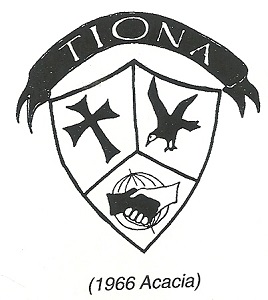 Tiona
was originally the designation of a basic residence unit for men during
the 1957-58 school year. Tiona is a Polynesian term for "Zion" which was
used during the 19th century for a branch of the RLDS Church in Tahiti
and later for the Australia reunion grounds. Under the new housing
system of 1962, Ullery Hall became the home of Tiona House, Tiona being
one of three basic residence unit names that were continued [Edwards and
Stewart Manor being the other two. Tiona
was originally the designation of a basic residence unit for men during
the 1957-58 school year. Tiona is a Polynesian term for "Zion" which was
used during the 19th century for a branch of the RLDS Church in Tahiti
and later for the Australia reunion grounds. Under the new housing
system of 1962, Ullery Hall became the home of Tiona House, Tiona being
one of three basic residence unit names that were continued [Edwards and
Stewart Manor being the other two.Tiona's original house colors were maroon and white; the house symbol was a shield with a cross on the left which represents courage and brotherhood through Christ. Tiona House's original officers were: president Clive "Lane" Hutton, vice president/secretary Bob Ritchie, chaplain Paul Lundy, and associate chaplain Ralph Patterson. A house paper entitled The Tiona News was first published on November 12, 1962 with Paul Gage editor. With the February 25, 1963 issue, the paper was renamed Tiona Trumpet which was continued into the 1964-65 school year. In the 1963 Acacia Tiona and Solah House boasted that they were the first to have a brother-sister house tug-of-war which took place across the end of Big G Lake. After residing in various locations throughout the years, Tiona moved to the top floor of Gunsolley Hall in the fall of 1976. This location was made permanent later in that school year. During the spring of 1985, it was announced hat due to declining enrollment the first floor location of Edwards House would be closed. Tiona and Edwards Houses merged to for Orion House, which began that fall on the top floor of Gunsolley Hall. In 2013, the lower floor of Graybill Hall, formerly office space for Development, became the home of the newly reinstated Tiona House. |
| Traver House |
 A
women's residence hall house, Traver was one of the first houses to be
named during October of 1962. The house was named after Ted Traver,
1960-64 English and speech faculty member. The house colors were royal
blue and white; the house symbol was a capital "H" crossed by a capital
"T". Traver House originally was located in the first and lower levels
of Walker Hall. Traver's first house president was Suzanne Fisher. Agape
was Traver's brother house. A
women's residence hall house, Traver was one of the first houses to be
named during October of 1962. The house was named after Ted Traver,
1960-64 English and speech faculty member. The house colors were royal
blue and white; the house symbol was a capital "H" crossed by a capital
"T". Traver House originally was located in the first and lower levels
of Walker Hall. Traver's first house president was Suzanne Fisher. Agape
was Traver's brother house.After various locations over the years, Traver House moved to the north wing of Patroness Hall in the fall of 1977. Traver and Paloma were the last houses to occupy Patroness Hall before it was converted into offices in the summer of 1979. Traver relocated to the middle floor of the north wing at Tess Morgan Hall. In the spring of 1985, Traver and Kimora merged to form Amici House which debuted at south Tess Morgan Hall in the fall of 1985. |
|
SOURCES: Goehner, David. “The Graceland College Book of Knowledge:
From A To Z.” Pp. 2-3, 14-17, 19, 22, 31, 34, 45, 50-51, 54, 73-74,
83-84, 106, 135, 137, 162, 168-69, 178, 188-90, 203, 207, 235-36,
273-74, 282-83, 288-89, 307-08, 310. Herald House. Independence MO.
1997. "Powell House Created." "Tiona House Reinstated." Horizons. Vol.
29, No. 2. p. 4. Graceland University. Lamoni IA. Fall 2013.
Transcriptions by Sharon R. Becker, January 2016. NOTE: Graceland University expressly granted permission to Decatur County IAGenWeb to use photographs and materials for the sole purpose of this website. Please, extend courtesy toward Graceland University and Decatur County IAGenWeb ~ ask before you "borrow" from this site. Thank you. These pages have been updated and reformatted by Conni McDaniel Hall, October 2019 |
| Graceland University *** Schools Directory *** Decatur County IAGenWeb |